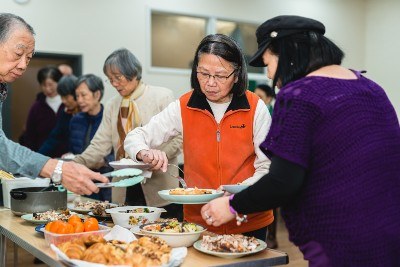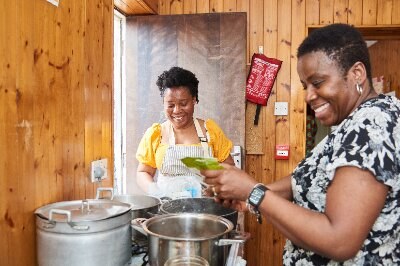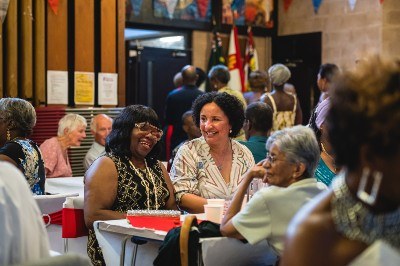
Reducing the carbon footprint of community events
Community events from street parties and village fêtes to regular play groups, youth clubs and social get-togethers create connections, help people feel part of a community, and provide much needed support.
But they can also create all kinds of waste. Here you can find tips to cut the carbon footprint of your events and minimise waste.
Listen to this article
You can listen to this article as a sound recording, lasting 15 minutes and 17 seconds, by clicking the button below.
1. Avoiding single-use products

We often need extra items to accommodate a bigger group of people, from chairs and serving dishes, to decorations to create a welcoming atmosphere. But there are ways to do this without creating a lot of waste while saving money:
- Borrow or rent furniture or party equipment you may use only once. Look for a library of things in your area, where you can find anything from gazebos, speakers, microphones and cables, to pressure washers to help with preparation and cleaning up. Some organisers use the neighbourhood network Nextdoor to find tables and chairs, or work with other groups in the area to share resources. As well as reducing waste, borrowing these things can help you to avoid the complications of insurance, maintenance and long-term storage.
- Avoid disposable cutlery and decorations. This may seem like a small change, but the long-term effects are significant: a plastic item can take as long as 1,000 years to decompose, while the 2.5 billion disposable cups used in the UK every year have the carbon footprint equivalent of 33,300 cars being driven for a year. The sale of many single-use plastics is now banned, but even biodegradable alternatives create unnecessary waste. Instead, you could use durable tableware from your local charity shop, ask people to bring their own, or borrow some: the Party Kit Network hires reusable serving platters, decorations, and table linen. Other simple changes help too: serving tap water in a jug reduces the need for plastic water bottles.
- Invite people to make reusable decorations. As well as reducing waste, this can bring people together and help to build a party atmosphere. The Eden Project has lots of ideas to get you started. Emmaus Mossley’s Big Jubilee Lunch saw volunteers using scrap fabric to make their own bunting for the event. Also consider natural alternatives like flowers, as decorations like balloons and confetti can cause problems for local wildlife, even if they are biodegradable.
- Minimise event merchandise, which many attendees might throw away, such as gift bags and key rings. If you want to give people something to remember the event by, you could consider natural presents, like sunflower seeds or herbs, or even digital ones, like an online photo album of the event.
- Consider food options with less packaging. If you have storage, buy larger bags of products like rice and flour, which don't go off and will be used. Or look into seasonal produce from local farmers or growing schemes – this can also connect you to other residents, broadening the reach of future events.
- Think about using your event as a way to make lasting environmental improvements in your community. In Hampshire, the villages of Laverstoke and Freefolk wanted their Platinum Jubilee celebrations to do that. As well as investing in reusable decorations which can be used for years to come, the community came together to plant daffodils along the road between the villages, and supported the Queen’s Green Canopy scheme with native tree planting.
2. Preventing and reducing food waste

Food is central to most events, but we might prepare more than is actually needed, or end up throwing away less popular options. Food that ends up in landfill releases additional emissions like methane into the atmosphere, accounting for up to 10% of greenhouse gases.
We’ve found six ways to reduce food waste at your next event:
- Think who’s best placed to provide the food. Most hosts take care of catering, but it's worth considering whether participants might bring their own food. Try a potluck system, where people volunteer to bring food for everyone to share, though be aware that there will be less control over allergens and ingredient labelling. People can then take leftover food back home, or donate to others. Carnbo and District Community Hall Association in Kinross hosts summer BBQs where attendees are asked to bring their own food, crockery and cutlery to reduce waste. The group has also used a small National Lottery grant to invest in reusable equipment from gazebos to oilcloth table covers that are then used at different community events.
- Look for ways to avoid over-catering. You could ask people to respond to the event invite so that you know roughly how many will come – this makes it easier to estimate how much food is needed. Being open about this can help to start a conversation about food waste: why it matters, and how everyone can make a difference.
- Label food clearly, and list all ingredients and allergens if possible. This is not a legal requirement unless your group is a registered food business, but the Food Standards Agency recommends it. It also helps people to avoid taking things they don’t like or might be allergic to, reducing unnecessary waste.
- Plan for unavoidable food waste. Provide a raw food waste bin separately from litter bins, so that you can compost leftover food from plates – each kilogram of homemade compost can save over 100g of CO2 emissions. Compost Culture and The Royal Horticultural Society have guides if you’re new to composting.
- Donate or distribute surplus food. You can donate to others using free apps like Too Good to Go or Olio, or through local food banks or community fridges. If you have larger amounts, consider offering it to food distribution networks such as FareShare, the Felix Project, Hubbub, and Your Local Pantry.
- If you’re working with external caterers, look for those that prioritise reducing waste. This could be through tracking and reviewing past attendance and consumption data, or through making dishes from food that would otherwise be wasted.
Community lunches from surplus food
Elizabeth House Community Centre in Islington uses donations and surplus food to prepare community meals. On Wednesdays, staff prepare a vegetarian lunch for over 50s, who come to the centre for a gentle exercise class and meet others from the community. And a new hot bin composter is turning the food waste into compost, benefiting allotment projects in the area.
Reducing waste through sharing food
At the 2022 Pumpkin Festival in Llanidloes, food stalls used compostable or recyclable containers, and the leftover pumpkins from the carving stall went into a large batch of soup that was shared with the community for free. And the charity’s Hanging Gardens venue now collects surplus food, donating it to residents and using it to host communal meals.
3. Reducing the carbon footprint of the food you serve

You can reduce the environmental impact of the food you offer by making some changes to how you plan, choose and buy food:
- Cut down on meat and other animal-based products. Because land-use change and farming make up a considerable share of the carbon footprint, producing animal rather than plant-based foods tends to be more harmful to the environment. You could test meat-free options or, if meat is important, try using less of it and choose grass-fed, higher-welfare, organic meat. In London, Stanley Arts made a free vegan Caribbean lunch the centrepiece of its Green Coronation Get-Together. In Somerset, Green and Healthy Frome organised a conference that brought together the council, the NHS, charities, politicians, and residents to find practical, local solutions to climate change. To minimise the environmental impact of the event itself, the caterers only used durable tableware and served a plant-based lunch with locally sourced breads, dips, tarts and salads.
- Consider sourcing surplus food. The free app Too Good to Go lists local shops and restaurants that have unsold food available at a discount, and everyone can use Olio to see if their neighbours have surplus produce. The Social Farms and Gardens website lists over 2,100 local food growing projects that might have food to share. The Nigerian Catholic Community in North East London uses surplus food from the Felix Project for regular communal Sunday meals and healthy cooking demonstrations, with minimal food going to waste.
- Look into local suppliers to increase the share of locally grown produce. This requires less transport and storage, and can be more nutritious as it’s more likely to be fresh. Local farm shops, cafes and caterers are always a good starting point – and you can search for local food producers and outlets on websites such as Big Barn, Farm Retail Association and Soil Association.
- If your food is provided by caterers, check their green credentials. Do they use local suppliers? Do they use organic and higher welfare products? Do they donate their own surplus food to good causes?
- If your organisation has outdoor space and willing staff and volunteers, you could start growing your own food. This can help with food bills, improve access to locally grown food, and provide an attractive community activity. Have a look at the free guides and resources provided by Social Farms and Gardens to help you get started. In Glasgow, the Wing Hong Centre, an organisation that supports older people from the Chinese community, brings people together to grow Chinese vegetables that aren’t available in local grocery stores. Produce is cooked for the group’s regular lunch club.
- Consider getting your community involved in growing food for your events too – anything from herb pots on windowsills and tomatoes on porches, to potatoes in back gardens. This can increase knowledge of food that is better for health and the planet. The Big Lunch has a simple planting guide for those who’d like to have a go.
- And you can look for free food growing wild. Foraged food has a lower carbon footprint because it doesn’t use fertilisers or pesticides – though you should make sure that any foraging you do is safe, legal, and sustainable. The Woodland Trust has guidelines on foraging responsibly, and what to look out for each month. British Local Food has advice on relevant laws. Climate Action Middlesbrough runs foraged food workshops to encourage organisations across the city to get involved in collecting edible plants, fruits, seeds and fungi for their own use. Starting with games where participants guess the food with the highest carbon footprint, they also learn about the health benefits of foraged foods and different ways they can be used to benefit the community.
Calculating the carbon footprint of food
If you’re already quite experienced and looking for new ways to assess and reduce the environmental impact of food you serve, you may want to look into a "foodprint" calculator.
They can help you weigh up different options and consider alternatives. Some calculators use farming, production and transport rates from the US rather than the UK, but these can still be useful indicators.
- The BBC Climate Change Food Calculator shows how your own food intake compares to emissions from things like driving and heating a home.
- Event Food Carbon Calculator is a relatively simple calculator with limited menu options, but enables you to calculate options for a different number of guests and assess whether the options come with low, moderate or high emissions.
- The Vegan Society Carbon Food Calculator enables you to calculate the footprint of individual meals based on hundreds of different food and drink products.
- The Food Carbon Emissions Calculator takes into consideration emissions from things like transport and waste.
4. Location and travel

You can minimise emissions by carefully choosing the location of your event.
- If you’re hiring a venue, choose one with strong green credentials. We've helped some of our grant holders to build outstanding eco-friendly buildings: in Northumberland, Bardon Mill and Henshaw Village Hall was built using a mix of low and zero carbon technologies. It has a green roof planted with meadow flowers that absorb rainwater and purify the air, solar electricity, and an air source heat pump. The design maximises natural daylight, and uses earth to shelter, cool and insulate the building.
- As well as green buildings, look for strong policies on waste, sustainable catering, carbon footprint, and travel – does the venue offer charging for electric vehicles? The National Lottery-funded Going the Extra Mile project in Gloucestershire held their larger events at the Forest Green Football stadium, which FIFA has ranked as the “greenest football club in the world”. London’s Calthorpe Community Garden offers indoor and outdoor spaces for hire, while pioneering its own food waste energy system: food grown in the gardens is cooked in the community café, with waste going to create renewable biogas which again is used for cooking and heating.
- Check that the venue can be reached safely and conveniently by foot, wheelchair, bike, or public transport, so that people are encouraged not to drive. If you have keen cyclists in your group, look into venues with bike storage or facilities for charging e-bikes. In Ynysybwl, Vision for our Valley runs play schemes and upcycling workshops, always making sure these are held by bus or train routes.
- Support car-sharing, which saves money and carbon, and may help to introduce people and make connections. Setting up a group, for example on WhatsApp or social media, can help attendees organise this.
- If you’re organising larger events, you may want to look into a carbon calculator like myclimate, to help you get a better idea of the emissions linked to your event.
Want to find out more or share your story?
Read our top tips on making an environmental action plan and encouraging residents from your community to get involved in climate action.
If you’ve had success in reducing the carbon footprint of a community event, please do consider sharing your tips and experiences with us at knowledge@tnlcommunityfund.org.uk.